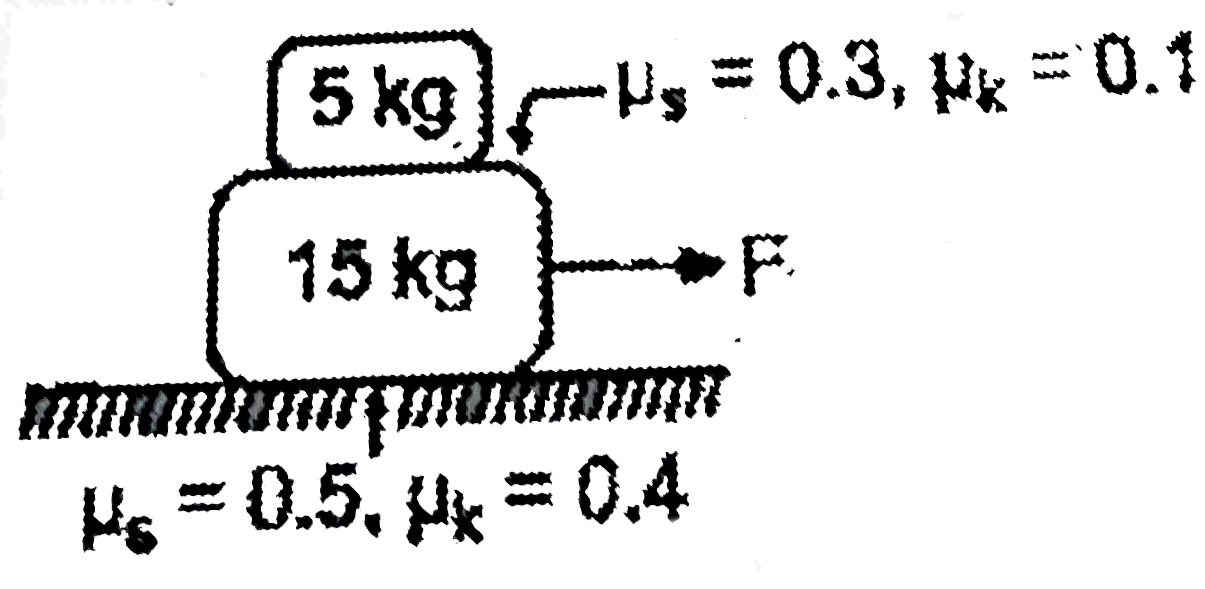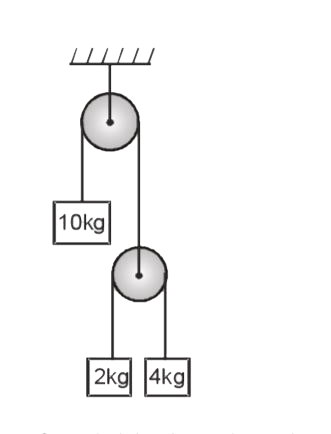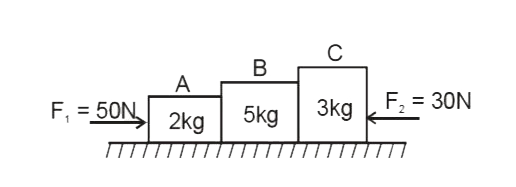In the Fig. 7.85 shown a constant force is applied on the lower block , just large sliding out from between the upper block and the table . Determine the acceleration of each block .

The correct Answer is:0.98m/s2,1.96m/s2
For upper block

f1=5×a1
a1=0.98m/sec2

For lower block

F−μkN1−μkN2=M×a2
F−0.1×5×9.8−0.4×20×9.8=15×a2 .....(i)
[Value of F = 310×5×4.9+510×20×4.9]
By putting this value of F in equation (i) , we get a2
Topper's Solved these Questions
- FRICTION AND CIRCULAR MOTION BOOK - GRB PUBLICATIONCHAPTER - FRICTION AND CIRCULAR MOTION EXERCISE - OBJECTIVE QUESTIONS ( only one choice is correct )
80 Videos
- FRICTION AND CIRCULAR MOTION BOOK - GRB PUBLICATIONCHAPTER - FRICTION AND CIRCULAR MOTION EXERCISE - More than one correct
18 Videos
- FRICTION AND CIRCULAR MOTION BOOK - GRB PUBLICATIONCHAPTER - FRICTION AND CIRCULAR MOTION EXERCISE - Comprehension type
11 Videos
- FORCE AND NEWTONS LAWS OF MOTIONBOOK - GRB PUBLICATIONCHAPTER - FORCE AND NEWTONS LAWS OF MOTIONEXERCISE - Comprehension
12 Videos
- MOTION IN A STRAIGHT LINEBOOK - GRB PUBLICATIONCHAPTER - MOTION IN A STRAIGHT LINEEXERCISE - Comprehension type Queston
14 Videos
Similar Questions
In the Fig. 2E.86 (a) shown a constant force Fis applied on lower block just large enough to make this block sliding outi from between the upper block and the table. Determine the force F at this instant and acceleration of each block. Take g=10m/s2.

View SolutionIn the figure shown, find out acceleration of each block.

View Solution
Knowledge Check
Two blocks of masses M = 3 kg and m = 2 kg, are in contact on a horizontal table. A constant horizontal force F = 5 N is applied to block M as shown. There is a constant frictional force of 2 N between the table and the block m but no frictional force between the table and the first block M, then the acceleration of the two blocks is-
A0.4ms−2B0.6ms−2C0.8ms−2D1ms−2Two blocks of masses M = 3 kg and m = 2 kg are in contact on a horizontal table. A constant horizontal force F = 5 N is applied to block M as shown. There is a constant frictional force of 2 N between the table and the block m but no frictional force between the table and the first block M, then acceleration of the two blocks is
 A0.4ms−2B0.6ms−2C0.8ms−2D1ms−2
A0.4ms−2B0.6ms−2C0.8ms−2D1ms−2
Find the minimum value of F to move the lower block between the upper block and the surface . Also, find acceleratuion of each block.

View SolutionTwo blocks of masses M = 3 kg and m = 2 kg are in contact on a horizontal table. A constant horizontal force F = 5 N is applied to block M as shown. There is a constant frictional force of 2 N between the table and the block m but no frictional force between the table and the first block M, then acceleration of the two blocks is

View SolutionFor the two blocks shown in the adjacent figure, an external force of 18N is applied on the lower block. Find the acceleratiion of the upper block.
View SolutionTwo blocks A(mA=5kg) and B(mB=15kg) are placed as shown in Fig A variable force F=200 starts actsing from time t=0 on lower bolck B just large anough to Determine the force F to make block B sliding out from between the blocks A and the ground at this instant , plot a graph between acceleration of both the blocks and time

View SolutionTwo blocks A(mA=5kg) and B(mB=15kg) are placed as shown in Fig A variable force F=200 starts actsing from time t=0 on lower bolck B just large anough to Determine the force F to make block B sliding out from between the blocks A and the ground at this instant , plot a graph between acceleration of both the blocks and time

View SolutionFind the contact force between the block and acceleration of the blocks as shown in figure.

View Solution
